| dc.description.abstract | The oil and gas sector in the North Sea is mature and consists primarily of brownfields that have passed their peak production or are close to the end of their lives. Many of these fields will have to be abandoned in the upcoming decade. The decision to abandon an oil and gas field carries a considerable cost, in addition to ending the future revenue stream of the field. If a field is abandoned before the optimal time, value will be lost as a result of revenue and profit losses. Conversely, if it is abandoned too late, value will be destroyed as a result of carrying higher costs than revenues, i.e., as a result of negative profits. Therefore, the timing of the abandonment decision is critical as it can either destroy or create significant value. Adding to the overall challenge of identifying the optimal abandonment time is the uncertainty associated with many of the value-determining parameters, such as price, cost, and production. The best method to identify the optimal time is to apply a consistent decision analytic approach, which includes uncertainties and the operator’s flexibility in choosing when to initiate the abandonment.
In this thesis we develop a case study representative of an oil field with declining production. We then implement three different approaches to estimate value and determine the optimal abandonment time. The three methods are: (i) a negative cashflow approach that abandons the field at the first negative cashflow, (ii) a greedy optimization approach that abandons the field after an already determined set waiting time criterion is fulfilled, and (iii) a real option valuation method that abandons the field when the economic outlook becomes unfavorable. The results were compared and evaluated, after which the greedy and real option valuation approaches were further assessed using sensitivity analysis.
We conclude that value is almost always gained by not abandoning the field at the first negative cashflow. Using a waiting criterion for the abandonment decision significantly improved the timing, resulting in a higher net present value. The best method for our case is real option valuation, which creates value through the combined effects of uncertainty and flexibility. | |
